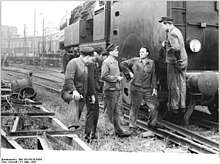DR Class 65.10
The DR Class 65.10 was a four-coupled passenger train tank engine operated by the East German Deutsche Reichsbahn (DR) for heavy suburban and commuter services.
| DR Class 65.10 | |
|---|---|
65 1049 of Deutsche Reichsbahn | |
| Number(s) | DR 65 1001 – 65 1088 |
| Quantity | 88 DR |
| Manufacturer | LEW (Prototypes) LKM (Production) |
| Year(s) of manufacture | 1954–1957 |
| Retired | 1977 |
| Wheel arrangement | 2-8-4T |
| Axle arrangement | 1′D2′ h2t |
| Type | Pt 47.18 |
| Track gauge | 1,435 mm (4 ft 8 1⁄2 in) |
| Length over buffers | 17,500 mm (57 ft 5 in) |
| Service weight | 113.0 tonnes (111.2 long tons; 124.6 short tons) |
| Adhesive weight | 71.0 tonnes (69.9 long tons; 78.3 short tons) |
| Axle load | 17.5 tonnes (17.2 long tons; 19.3 short tons) |
| Top speed | 90 km/h (56 mph) both directions |
| Indicated Power | 1,103 kW (1,500 PS; 1,479 hp) |
| Driving wheel diameter | 1,600 mm (5 ft 3 in) |
| Leading wheel diameter | 1,000 mm (3 ft 3 3⁄8 in) |
| Trailing wheel diameter | 1,000 mm (3 ft 3 3⁄8 in) |
| Cylinder bore | 660 mm (26 in) |
| Piston stroke | 600 mm (23 5⁄8 in) |
| Boiler length | 9,987 mm (32 ft 9 1⁄4 in) |
| Boiler Overpressure | 16 bar (1.60 MPa; 232 psi) |
| No. of heating tubes | 158 |
| No. of smoke tubes | 30 |
| Heating tube length | 4,200 mm (13 ft 9 1⁄4 in) |
| Grate area | 2.04 m2 (22.0 sq ft) |
| Superheater area | 47.39 m2 (510.1 sq ft) |
| Evaporative heating area | 147.44 m2 (1,587.0 sq ft) |
| Water capacity | 16 m3 (570 cu ft) or 16,000 litres (3,500 imp gal; 4,200 US gal) |
| Fuel | Coal: 9 tonnes (8.9 long tons; 9.9 short tons) |
History

Like the DB Class 65 built for the Deutsche Bundesbahn in West Germany, the DR Class 65.10 was intended by the Deutsche Reichsbahn (DR) in East Germany for commuter traffic on suburban railways. The DR procured a total of 88 examples of this class, and 7 more went to the Leuna chemical works.
The Class 65.10 was developed after the Second World War as a powerful tank locomotive that would replace engines of classes 74, 75, 78, 86, 93 and 94.
Numbers 1001 and 1002 were built at VEB Lokomotivbau Elektrotechnische Werke (LEW), formerly Borsig Lokomotiv Werke (AEG), Hennigsdorf, and the production models at VEB Lokomotivbau Karl Marx, (LKM, formerly Orenstein & Koppel) Babelsberg.
Design
The vehicles had a welded locomotive frame, a welded boiler and mixer-preheater and large tanks in order to carry additional fuel (primarily brown coal bricketts). On the Class 65.10 the two axles of the rear bogie were housed in an outer frame unlike those of their DB Class 65 counterparts.
Number 65 1004 was the only German tank engine to be equipped with a Wendler coal dust firing system which, after modifications to the design, ran perfectly well. This modification was however reversed again in 1962. From 1967 the locos were fitted with Giesl chimneys.
Use
%2C_Th%C3%BCringer_Wald.jpg)
The 65.10s were stationed all over East Germany, except in the DR's northern locomotive depots (Bahnbetriebswerke or Bw), and in the 1960s were preferred as the motive power for commuter traffic with double-decker trains as well as on push-pull services. For the latter, engines 65 1009; 1015; 1017; 1025; 1026; 1034; 1058; 1063 and 1081 were fitted with push-pull equipment. The picture changed with the widespread appearance of the DR Class 118 diesels. The 65.10 was also used for goods train duties.
Preserved locomotives
Of the total of 95 examples produced, just three engines remain:
See also
| Wikimedia Commons has media related to DR Class 65.10. |